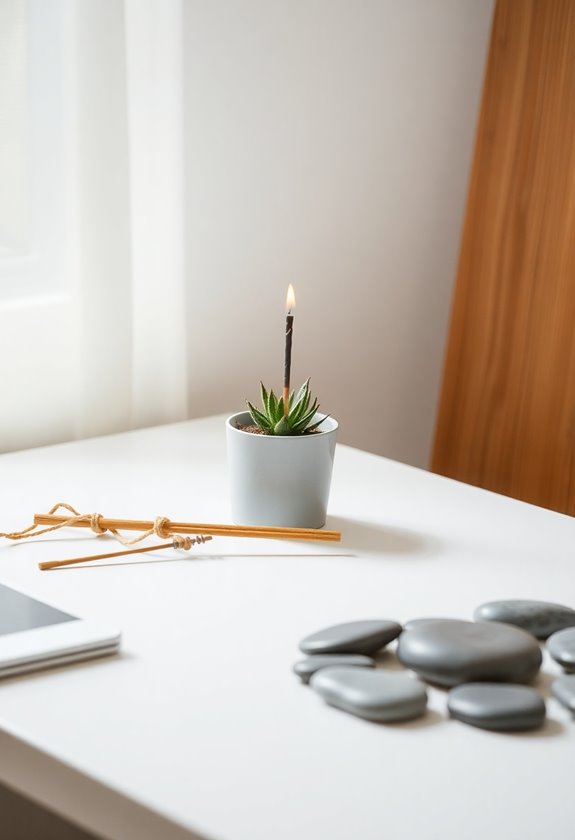You can effectively manage workplace anxiety through simple breathing techniques that take just minutes to practice. Start with box breathing: inhale for four counts, hold for four, exhale for four, and hold again for four. The 4-7-8 method offers another powerful option, where you'll inhale for four seconds, hold for seven, then exhale for eight. These techniques calm your nervous system, reducing common symptoms like racing thoughts and rapid heartbeat. When practiced regularly at your desk, these breathing exercises strengthen your resilience against work-related stress. Exploring additional techniques will enhance your ability to maintain composure throughout challenging workdays.
Highlights
- Practice box breathing by inhaling, holding, exhaling, and pausing for four counts each to quickly calm anxiety at your desk.
- Set hourly reminders to check your breathing pattern and take five deep breaths to prevent stress buildup.
- Use the 4-7-8 breathing method during stressful meetings by inhaling for 4 seconds, holding for 7, and exhaling for 8.
- Start your workday with three slow, deliberate breaths to center yourself and establish a calm mindset.
- Perform tactical breathing when anxiety strikes by inhaling for two seconds and exhaling for four seconds.
Understanding Workplace Anxiety

Many professionals experience workplace anxiety, a common condition that can manifest through racing thoughts, sweaty palms, rapid heartbeat, and difficulty concentrating. You're not alone if you find yourself feeling overwhelmed by deadlines, presentations, or workplace interactions, as these triggers affect millions of workers daily.
Your workplace anxiety might stem from several key factors:
- Performance pressure and fear of making mistakes
- Conflicts with colleagues or supervisors
- Heavy workload and time management challenges
- Job security concerns or career advancement stress
When you're dealing with workplace anxiety, it's important to recognize that it's a natural response to stress that you can learn to manage effectively. Understanding your specific triggers and how your body responds to them is the first step toward developing effective coping strategies through proper breathing techniques.
Quick Breathing Exercises

Learning simple breathing exercises can quickly calm your nerves during stressful workday moments. You'll find these techniques particularly effective when you're facing tight deadlines or challenging interactions with colleagues.
- Box Breathing: Inhale for four counts, hold for four, exhale for four, then hold again for four counts before repeating the cycle.
- 4-7-8 Method: Breathe in through your nose for four seconds, hold your breath for seven seconds, and exhale completely through your mouth for eight seconds.
- Tactical Breathing: Take a deep breath through your nose for two seconds, then exhale slowly through slightly pursed lips for four seconds.
You can practice these exercises discreetly at your desk, and they'll help reduce your heart rate and restore your sense of calm within minutes.
Box Breathing Method

Box breathing centers on four equal phases that mirror the shape of a square, making it one of the most straightforward anxiety-reduction techniques you'll learn.
Here's how to practice box breathing effectively:
- Inhale slowly through your nose while counting to four, feeling your lungs expand fully with each count.
- Hold your breath for another count of four, keeping your chest still and maintaining awareness of your body's sensations.
- Release your breath through slightly parted lips for four counts, emptying your lungs completely while maintaining control.
- Hold your lungs empty for a final count of four, noticing the natural pause before beginning again.
You'll find that repeating this pattern for 3-5 minutes can considerably reduce workplace stress and help you regain mental clarity during challenging situations.
Morning Centering Practices

Starting your day with intentional breathing exercises can set a positive tone for managing workplace stress before it builds up. You'll want to establish a quiet space where you can practice these techniques without interruption, ideally right after waking up.
Begin by sitting comfortably with your back straight and your feet planted firmly on the ground, then take three slow, deliberate breaths while focusing on the present moment. Next, try this simple morning sequence:
- Take 5 deep breaths, counting to 4 on each inhale and 6 on each exhale
- Place one hand on your chest and one on your belly, breathing deeply for 2 minutes
- Complete with 3 "cleansing breaths," exhaling forcefully through your mouth
Consistency with these morning practices will help you develop resilience against workplace stressors throughout your day.
Desk Meditation Techniques

A well-designed desk meditation practice can help you manage stress without leaving your workspace. You'll find that integrating short mindfulness sessions between tasks can reset your mental state and improve your focus throughout the day.
Begin by sitting with both feet flat on the floor and your hands resting comfortably on your desk or lap. Close your eyes and take three deep breaths, focusing on the sensation of air moving through your nose and filling your lungs. As thoughts arise, acknowledge them without judgment and return your attention to your breathing pattern. You can enhance this practice by setting a quiet timer for 2-5 minutes and incorporating gentle shoulder rolls or neck stretches while maintaining awareness of your breath's natural rhythm. Consider using mindfulness card decks to guide your daily meditation practice and add variety to your breathing exercises.
Building Better Breathing Habits

Developing better breathing habits throughout your workday can transform how you respond to stress. You'll find that intentional breathing becomes second nature when you practice these foundational techniques consistently:
- Set hourly reminders to check your breathing pattern, ensuring you're drawing air deep into your diaphragm rather than taking shallow chest breaths
- Practice the "box breathing" method during challenging tasks, which involves inhaling for four counts, holding for four, exhaling for four, and pausing for four
- Position your workstation to promote good posture, as your spine's alignment directly affects your breathing capacity and oxygen flow
- Start your morning by taking ten mindful breaths before checking emails, establishing a pattern that you can return to whenever tension builds throughout your day
Frequently Asked Questions
Can Breathing Exercises Affect My Job Performance and Productivity Levels?
Breathing exercises can greatly boost your job performance and productivity by increasing oxygen flow to your brain, which enhances focus and mental clarity. When you practice controlled breathing, you'll reduce stress hormones that interfere with decision-making and cognitive function. Research shows that regular breathing exercises can improve your attention span by up to 50% and help you maintain peak performance throughout demanding workdays.
How Long Should I Practice Breathing Techniques Before Seeing Noticeable Results?
Picture Sarah, who noticed her stress levels dropping after just one week of consistent breathing practice. You'll typically start experiencing initial benefits like improved focus and reduced tension within 5-10 minutes of each session. For lasting results, you'll need to practice consistently for 2-3 weeks, dedicating at least 10 minutes daily. Many people report significant improvements in their stress response and emotional regulation within a month of regular practice.
Should I Tell My Coworkers or Boss About Using Breathing Exercises?
Whether to share your breathing practice is a personal choice that depends on your workplace culture and comfort level. You don't have to disclose this coping strategy unless you want to, as it's a private wellness tool. If you do choose to share, you might inspire others who are dealing with similar challenges, but remember that maintaining professional boundaries while discussing personal practices is important.
Can Breathing Exercises Help With Physical Symptoms Like Headaches and Muscle Tension?
Yes, breathing exercises can effectively reduce physical symptoms like headaches and muscle tension by increasing oxygen flow throughout your body. When you practice deep breathing, you'll trigger your body's relaxation response, which helps release tight muscles and reduces tension-related head pain. Your controlled breathing patterns will lower stress hormones in your bloodstream while promoting better blood circulation, which naturally eases these physical discomfort symptoms.
What Should I Do if Breathing Exercises Make Me Feel More Anxious?
Ever feel like breathing exercises are doing more harm than good? You're not alone, and there's a solution. If breathing exercises increase your anxiety, start by taking smaller, gentler breaths rather than deep ones. Try counting your regular breaths without changing them, or switch to grounding techniques like focusing on your surroundings. It's also helpful to work with a therapist who can guide you through modified techniques that better suit your needs.




